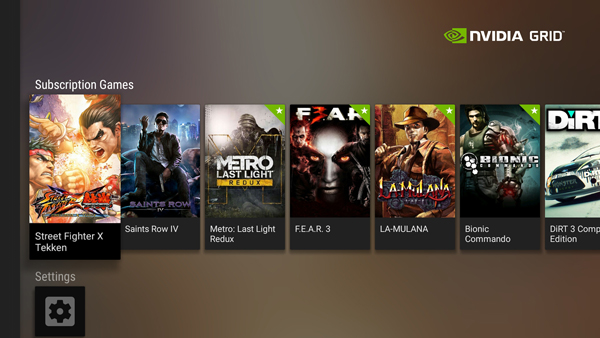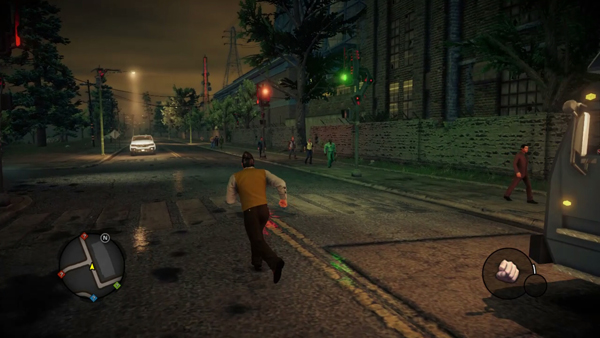Nvidia Shield Android TV Console Review
Today we take a look at the latest addition to Nvidia's Shield line of gaming devices. No mobility here, this new Shield is for the living room!
Why you can trust Tom's Hardware
GRID Streaming
Another way to play games is through Nvidia’s GRID service, which streams games from a server straight to Shield. Until recently, all of the games on GRID were running at 1280x720 resolution and 60 frames per second. Nvidia recently upgraded GRID ahead of Shield’s launch so that it now supports a 1920x1080 resolution at 60 frames per second. However, the full HD gaming experience requires pretty high bandwidth, with Nvidia recommending a constant 30Mbps! Those with at least 10 Mbps will still be able to play at the 720p resolution, though.
In my home, the highest bandwidth I had available was around 23Mbps, and that’s with no one else at home using other connected devices. At that speed, games like Dirt: Showdown, Batman: Arkham Origins and Saints Row IV were very smooth and didn’t have any stuttering issues. Latency wasn’t a noticeable issue either.
That quickly changed when other family members used up bandwidth for browsing, social media and Netflix. At one point, I only had 13Mbps for GRID, and while it’s still within Nvidia’s acceptable range for GRID at 720p gameplay, I wouldn’t recommend it to anyone. Stuttering became slightly more apparent, and a few rendering issues came up, such as a disappearing section of the road or a streak of black emanating from the player’s character. Latency was very noticeable, especially with a few audio delays, but the controls still worked. I was still able to move around and the character would respond almost immediately. However, the decreasing quality and latency in other areas would become too big to ignore at some point.
With the limited storage space inside Shield, GRID is a necessity to gamers. The ability to stream games is still fairly new to the market, and Nvidia is trying to capitalize on it by providing well-known titles without having to deal with issues such as installing large games in the small device. Of course, you’ll need to have the necessary bandwidth to actually play these games without any problems. On top of that, GRID is turning into a subscription-based service at the end of June, so consumers will eventually have to pay a premium to play games at full HD. At least you’ll have a whole month to decide if GRID is the best choice or whether a console or PC is still the way to go.
Get Tom's Hardware's best news and in-depth reviews, straight to your inbox.
-
jasonelmore keep the shield devices coming nvidia! that gpu score.. can't wait to see it in their tablet next month.Reply -
Per Wigren FINALLY a review that tests GameStream. I can't believe how there can be so many reviews out there and just about no one that bothers to try this rather major feature, considering it's produced by Nvidia and comes with a gamepad... Thank you!Reply
The result is rather discouraging, however. Did you use it at 1920x1080 at 60 FPS? Was the game set to that resolution on the PC as well? -
Valld Nice review, just a few mistakes in the specifications:Reply
1. There are moving parts inside - the cooling fan, clearly visible on the photo
2. Bluetooth version is 4.1/BLE, not 2.1
3. Micro SD card slot supports cards up to 128Gb, not 2Tb -
Eggz Interesting! People with HTPCs will be looking for something given that Windows 10 won't have Windows Media Center any more.Reply
I think that creates an open market, and I'm curious to see whether Ceton will hire some programmers to come up with a piece of software that supports all of the WMC functionality, and whether they or anyone else will solve the OnDemand functionality issue that's now exclusive to cable boxes. -
Zepid What a shit review. No codec information, no playback benchmarks for local media. No information as to if you can mount USB storage to be readable natively by Android apps (as in can I plug in a USB HDD and see it without doing anything in say... VLC). Because Android TV doesn't support this by default without a root or custom ROM, I assume Nvidia has this feature enabled but ZERO REVIEWERS have bothered mentioning it.Reply -
clonazepam Where's the gamepad review? Stream Dark Souls I/II to the thing and really hammer on the d-pad with weapon swaps / item use, and report back. Thanks! :)Reply
"Git gud casul." -
Emanuel Elmo I made this correction before and nobody seems to have corrected it.Reply
The $299.99 model of the shield comes with a 500GB HDD and NOT a 200GB HDD.
I will say this again that it can be confirmed off of the Nvidia website. -
thrus Something that bugged me early in the article since your internet was only 23Mbps you couldn't reliably stream 4k from Netflix, but the gigabit port make HD work fine. If the port was all that mattered it far exceeded the recommended 25Mbps for 4k as well. The gig port had nothing to do with your streaming, heck an old 100Mbps port would be 4 fold the required throughput for 4k. keep the specs in the specs section and don't try to shoehorn them in where they are irreverent.Reply -
deppman I have the 500GB Shield. The Talos Principle can be set to 1080p rendering and it looks and performs very well. I'm not sure why it defaults to 720p rendering. The Wi-Fi results in less lags and hiccups than the Shield Tablet, so game streaming is better nearly glitch-free IF your network isn't busy. Video streaming is flawless, and even Chromecast improves. Also, Google just released 600 more TV apps, so selection is greatly improved. Now if I could only install a browser.Reply

